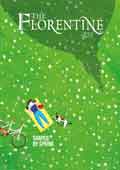LIGHT MODE
DARK MODE
Most popular
The Florentine

ART + CULTURE
The epitaph on her tombstone at the Cimitero degli Allori (Evangelical Cemetery of Laurels), just outside Florence, tells us ‘she was gay, unselfish, brave,’ but Alice Frederica Keppel had one other invaluable quality: she was discrete. This was to make her the last and longest-serving mistress of
If, like me, you are a fan of the British costume drama series Downton Abbey, you were probably pleased to read in the newspapers recently that the show has generated enough money to pay the 11.75 million pounds so desperately needed for the repairs at Highclere Castle in Berkshire,
A large whitewashed villa named La Rondinaia (‘Swallow's Nest'), wedged on a sheer cliff face in Ravello, overlooking the Amalfi coast, was the place where prolific American novelist, playwright, essayist and pundit Gore Vidal, lived and worked for more than 35 years. From this lofty perch high above
American writer and patron of the arts Mabel Dodge (also known, in recognition of her four husbands, as Mabel Evans Dodge Sterne Luhan), was born Mabel Ganson on February 26, 1879. She was the only child and heiress of a wealthy but unloving family in Buffalo, New York. After a
There is a charming drawing, Leaving Montepulciano, in the current exhibition, Americans in Florence: Sargent and the American Impressionists, at Palazzo Strozzi (see TF 159). One of the eight works in the show by American printmaker, illustrator and writer Joseph Pennell, it depicts the artist and his wife, writer Elizabeth
The portrait of American author Henry James is amongst the paintings by John Singer Sargent (1856-1925) currently at Palazzo Strozzi in the exhibition Americans in Florence: Sargent and the American Impressionists (see TF 159). James was a close friend of Sargent and instrumental in promoting the artist's career
Marguerite Guggenheim, known to all as Peggy, was one of the most important collectors of modern art of the twentieth century. With a sharp and refined eye, she collected ...
The pursuit of knowledge and business acumen appear not to be mutually exclusive. Consider Giovan Pietro Vieusseux, the man whose scientific and literary gabinetto (?reading rooms') in Florence not only linked Italian and European culture but were also an important resource for those pursuing Italy's unification over a century
This time of year, we start thinking about bikini waxes and getting into perfect shape for those lazy, hazy days on the beach. To help us, every day there seems to be a new diet fad to try that frequently turns out to be a nutritional nightmare. Yet there have
John Blake MacDonald's 1880 painting Lochaber No More depicts the mournful moment on September 20, 1746, when Prince Charles Edward Stuart, the Young Pretender to the English throne, commonly known as ?Bonny Prince Charlie,' left Loch Nam Uamh in his beloved Scotland forever. After his rout at the battle
For a time, Italy's greatest actress of the Belle Époque, Eleonora Duse, lived in a villa in Settignano.
On July 10, 1973, John Paul Getty III, the grandson of John Paul Getty, the owner of the Los Angeles-based Getty Oil Company and founder of the California museum that ...
At the end of World War II, Italians were asked to decide whether they wanted to retain their monarchy or to become a republic. Women, for the first time, also voted in the plebiscite. In the referendum held on June 2 and 3, 1946, the republican side won by a
